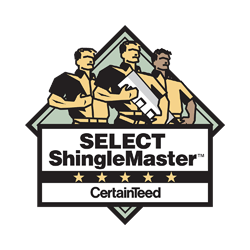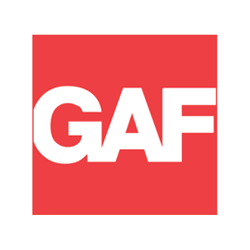Vertex Roofing Contractors is the leading Utah Roofing construction company installing roofing in Salt Lake City for since 2009. Our team of professional roofing installers are well experienced, offering a wide range of services, and are all certified, licensed, and insured. Our company's commitment to the highest quality of workmanship and professional customer service is well proven by reviews reflecting our roofing staff's success in exceeding our customers' expectations. To learn more about the kinds of roofing we install or to get a free bid, contact Vertex Roofing Contractors today.
Quality Roofing Materials
Vertex Roofing Contractors offers a full array of roofing materials. We use the finest materials from top manufacturers like Certainteed, Owens Corning, and GAF.
Types of Roof Shingles and their Benefits
As you can see in the descriptions of the different shingle types below, there are abundant choices of roofing materials. Typically, the emphasis in choosing a material should be on which type of roofing is appropriate for your building's architecture, your community's zoning requirements (if applicable), your region's climate, and your personal preferences.Asphalt Shingles
 Asphalt shingles are used for exterior siding or roofing due to asphalt's efficiency as a waterproofing material. Asphalt roofs are widely used by U.S. home and business owners, because these work very well across various regions of the North American climate. Asphalt provides functionality at a relatively inexpensive price. It's also quicker and easier to install than other premium materials. So, it's less expensive to install. The life expectancy of an asphalt roof is typically 15-25 years. Together, these benefits make asphalt roofing one of the most cost-effective roofing options.
Asphalt shingles are used for exterior siding or roofing due to asphalt's efficiency as a waterproofing material. Asphalt roofs are widely used by U.S. home and business owners, because these work very well across various regions of the North American climate. Asphalt provides functionality at a relatively inexpensive price. It's also quicker and easier to install than other premium materials. So, it's less expensive to install. The life expectancy of an asphalt roof is typically 15-25 years. Together, these benefits make asphalt roofing one of the most cost-effective roofing options.- Readily available
- Least expensive roofing material
- Less expensive installation than other roof types
- Quick installation
Metal Roofing
A metal roof installed by Vertex is made of steel. Steel roofing is also coated with a metallic rust-proofing material. (Aluminum roofs do not have this finish.) The steel material is cut to fit the shapes of the roof sections, and then installed. Metal roofs are ideal for homes, cabins, and commercial buildings that are frequently exposed to severe weather. The life expectancy of a metal roof is from 40 to 70 years. The following are some benefits of metal roofs.- Reflects heat (instead of absorbing it, as asphalt does)
- Very resistant to cracks and corrosion
- Withstand severe storms with high winds (up to 140 mph)
- Superior in shedding ice and snow, keeping the load off the roof and the building's structure
- More energy efficient, can lower cooling costs as much as 25% by reflecting sunlight.
- Withstand heavy impact by objects (ideal for a cabins in forest areas)
- Fireproof
- Can be installed over fiberglass or asphalt roof, affording extra insulation layer
- Less maintenance than asphalt roofs
- Wide variety of colors and design profiles
- Solar panels are easily housed on metal roofs, affording green lifestyle and cost-savings
- Environmentally responsible, made of at least 25% recycled material. Also 100% recyclable after roof is eventually no longer in use
- Savings available, some metal roofs may contribute to LEED credits to owners of buildings constructed using green materials
Rubber Roofing
Rubber roofing is a modern, versatile material made from ethylene propylene diene monomer (EPDM) a synthetic material manufactured from natural gas and oil. EPDM is waterproof. It is ideal for commercial buildings with flat roofs or roofs with complex design features that must be effectively worked around with roofing materials in order to ensure against leaks. The material comes in black or white, and It can be applied by sealing the edges to the roof decking, or gluing down the entire underside of the rubber sheets, attaching the sheets with nails, or other methods. A properly installed sheet rubber roof may have a life expectancy of up to 50 years. Rubber roofing offers numerous functional and cost benefits over traditional roofing materials.- Low Maintenance
- Low incidence of cracking or leaking
- Easily and inexpensively repaired
- Light weight
- Durable
- Versatile, can fit and last in places that other materials cannot
- Fireproof, can significantly slow down a building fire
- Energy Efficient, resists UV rays, but also retains heat inside the building, improving energy costs year-round
Other Flat Roofing Materials
In addition to EPDM rubber roofing, flat roofs are available in several other types: One option is TPO, a membrane that can be unrolled and then heat-welded to form a bond between sheets that is much stronger than on an EPDM roof. A flat TPO roof is common for residential, commercial, and industrial customers. Another choice is Modified Bitumen, a single-ply material for peel and stick application. Yet another alternative is a Built-Up Roof (BUR), which involves the traditional application of multiple layers of hot tar, gravel, and fiberglass membranes. Each of these material choices, like any kind of roofing, presents various pros and cons.TPO Flat Roof
- Strongest of the bonded roof types (much stronger than EPDM)
- Withstands puncturing
- Cost more than other options
Modified Bitumen Flat Roof
- Easy to install peel and stick
- Reasonably priced
- Light colored surface reflects light, saves on utility bills
- Old-fashioned torch-down installation method is extremely dangerous to the house and inhabitants during installation
- Not as strong as rubber membrane roofs
Built Up Roof
- Comparatively very inexpensive
- Gravel roof helps to protect against fires
- Attractive aesthetic for many home design types
- Heavy weight on structure
- Can be extremely difficult to locate leaks
Composite Shingles
Composite shingles are composed of state-of-the-art engineered polymers. These high-tech shingles are designed to look like natural slate or wood, and other roofing materials. The backing used in synthetic shingles are made of integrated polymeric material. This makes composite shingles much more durable than the natural materials, like slate tiles, which are more brittle and frequently broken. In fact, composites are among the industry's highest rated roofing materials for impact resistance. Important advantages in using synthetic shingles include the following.- Require less maintenance
- Longer lasting
- Fire resistant
- Available in a variety of aesthetic styles
- Can be made from recycled rubber products (such as car tires)

GAF Roof Shingles Installed by Vertex Roofing Contractors
Roofing shingles are the most important element of any roof repair or replacement. The following shingles are available in either asphalt or composite materials:- Three-Tab Roofing Shingles: An ideal choice on a limited budget. Ideal for homeowners who need reliable all-weather shingles that have classic detailing.
- Timberline ® Lifetime Roofing Shingles: The #1-selling shingles in North America. These highly popular shingles are architecturally stylish and also very practically priced. The result? A high-performance shingle. We have GAF's proprietary beautiful color blends,
- Timberline Ultra HD® Shingles have a bold wood-shake look with an incredible thickness and a lifetime warranty. Specialty Lifetime Roofing Shingles: The solution for those who want impact resistance shingles that help save energy. Also with a lifetime warranty.
- Designer Lifetime Roofing Shingles: These are beautiful but also stylish, and exceptionally durable designer shingles with a lifetime warranty.
Roof Shingle Prices
People tend to think that roofing is just the cost of the shingles, however, when considering roof repair costs, you must consider the cost of accessories that are part of any complete roofing system. Roofing Systems consist of the following components: Shingles- Underlayment: Felt, Synthetic, Ice & Water Shield
- Hip / Ridge Hip / Ridge cap
- Flashing
- Drip edge metal
- Ventilation (ridge vent)
- Pipe boots
- Lead & step flashing
- Nails, caulking, and other small things
How much does a new roof cost?
Roofers charge by "squares." This is a single 10-by-10-foot patch of roof. The average residential roof will use between 22 and 26 squares when replaced. A roofer will charge for the cost of removing an old roof. A one-story roof with a single shingle layer will cost between $100 and $150 per square to remove. If you have a double layer it will cost $115 to $165. A roof with triple layers will cost roughly $125 to $175 per square foot. Prices are generally higher for roofs that are particularly steep. Prices for asphalt shingles, the common type of shingles, will cost between $120 and $140 per square. Other kind of roofing materials such as slate and clay tiles, wood shake roofs and roofs made from metal have higher costs. A typical metal roof will cost between $350 and $1100 per square foot. The average roof replacement cost will range from $5,000 – $12,000 in total.Certified Vertex Roofing Contractors in Salt Lake City, Utah
If you would like additional information about our roofing material options we install, our Roof Tear-Off And Roof Overlay Services In Utah, or to make an appointment, contact Vertex Roofing Contractors to speak to one of our roofing experts. Just ask for your free bid and learn about our financing options and roofing warranty.Educational Pages:
Roofing Installation ProcessVertex Roofing Contractors Blog
